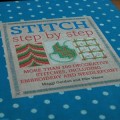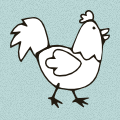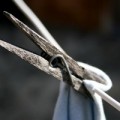Stitching etc tips from the Knitting & Stitching Show
I’ve been at the Knitting & Stitching Show in Harrogate today.
As I’m not particularly one for just browsing shops (especially at the moment) or just wandering aimlessly, my main focus has been on the workshops. I did four today and have another four lined up for my return visit on Sunday.
Today I did: the Shibori Blues (indigo/cloth resist dyeing), Intro to Crewel Embroidery, Japanese Embroidery & Embellishing Quilts. They were all interesting but were rushed trying to fit everything into an hour. Embellishing Quilts was the one I was least excited about going into it but I think has been the most valuable (since I want to start quilting); the Japanese Embroidery had the steepest learning curve (having to twist our own threads from the thinnest silk!). Shibori Blues & Crewel Embroidery largely went over things I’ve done before (the former on a general natural dyeing course in February, the latter from a kit I did around the same time) but the latter especially was useful because I had a chance to ask questions about refining my techniques etc.
As well as the subject specific things I learnt in the sessions, I also picked up a lot of general stitching/quilting/misc hints and tips. Some of them may be obvious but they’re new to me. I thought I’d post them here in case they’re new to you too – and to remind me of them, because I’ve not exactly got a lot of processing/practising time these next few days (normal sewing class tomorrow, a comic con on Saturday then back to Harrogate on Sunday – and a novel to finish, as well as everything else that needs doing as usual!).
- If you can’t thread a needle, try approaching the hole from the other side – the eyes are punched out so the hole on one side is usually bigger than the other. (This is not a trick I need as being able to thread needles is one of my superpowers. I am Needle Threading Girl!)
- Don’t lick thread to seal the ends to thread it through the needle’s eye – it apparently swells the fibres
- Use self-threading needles for sewing in the tiny ends – this was an in-passing tip so I didn’t get all the details but I think it would be useful for sewing in the ends of crochet motifs, maybe?
- The waste knot method is the best way to start (crewel) embroidery – though it takes some mental rewiring!
- Start the waste knot method about a centimetre along the stitch line (for line work) so the anchor stitches will be hidden – the waste knot can be anywhere in the same colour space for space work
- Wrap embroidery hoops (both the inner and outer) with bias binding tape or strips of calico to improve the grip – it means you don’t have to over-tighten the hoop and does less damage to the fabric
- Take shower caps from hotels to protect embroidery work – didn’t quite hear the start of this so not sure if it was just while travelling or during reworking…?
- Shower caps are also good for swimming costumes post-pool – rather than wrapping the costume in a towel
- Long and short stitch in crewel embroidery should really be called Long and Longer Stitch – I asked how to make it look good and the simple answer was ‘practise’. The longer answer was:
- Don’t work in just one area at a time when doing long & short stitch – working across the whole area to be filled, sew in the (first round) long stitches to give you an idea of shape/angle before starting on the shorter stitches. Also don’t be afraid to mark the fabric first to plan where they’re going to go.
- Practise was the main repeated advice throughout the three sewing-y workshops – I think of the kits I do as practise/learning new techniques but I think there is a lot of value in doing very small pieces (max 6×4/10cmx15cm) that are nothing more than doodles.
- There is not enough time between Knit & Stitch workshops to either get a cup of tea or eat sandwiches – I thought there was time for tea but there was not and I was late. Plan accordingly!
- Carbon paper is much more effective for image transfer than I thought it would be – I really should try more image transfer stuff
- Everyone tells me Colonial Knots are better than French ones – not sure why yet, will check it out!
- Lakeland do rubber gloves with a cuff at the wrist end – useful for dyers etc – stops the liquid from the hands running up your sleeve
- I saw several examples of quilting/stitching with the design in negative space – just something I hadn’t thought of doing before and something I want to try now.
- Ribbon flowers – do a running stitch along the top of the ribbon (rather than the middle) – they’re easier and more ribbon efficient
- Use a darning foot for machine quilting – can’t remember why, was just told that by someone from a Quilters’ organisation so I believe them ;)
- Use deliberately different shapes/lines for crazy patchworking – just easier!
- Iron-on wadding is good for quilting beginners – one less thing to worry about – it isn’t good for blanket quilts (it’s too stiff) but it’s fine for small decorative pieces/wall hangings
- Iron-on wadding needs to be bubble side up – that’s the glue side
- Make sure all the iron-on wadding is covered before you iron it – the glue will melt and will NOT come off the iron
- Don’t use plastic headed pins for quilting – they melt when you iron over them
- Use a piece of velvet as a mat while doing (seed) beadwork – it makes the beads easier to pick up and stops them rolling about too
Think that’s it – though I’m sure to learn more random stuff on Sunday! (If anyone else will be there on Sunday, I’m doing the Silk & Spindle workshop, then ribbon embroidery, pieced patchwork bowl and Japanese padded fabric pictures, and I might try to fit in a little drop-in batik as well. Basically, I’ll be in Hall E!)
Do you have any favourite stitching tips?







Hi! I just found your blog when I searched how to make a frugal beanbag. I’m using a rolled up duvet instead of beans though, ha. Less messy that way. I love your tips on sewing, since I just started embroidering a vintage bedsheet and struggling just a bit. Anyway, love your blog – its always nice to meet like minded folk! :)
Welcome back! I’ve missed your posts.
Brilliant tips. I didn’t get to the Knit & Stitch Show this year. Next year, I plan to do a quilting class, if they offer one.